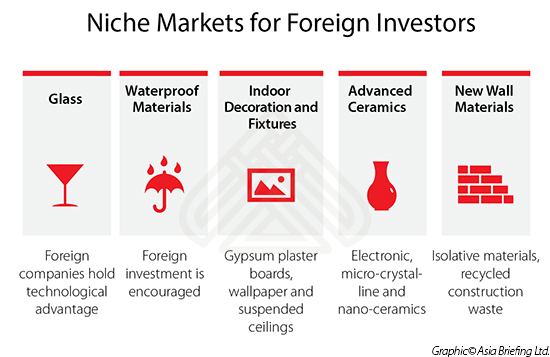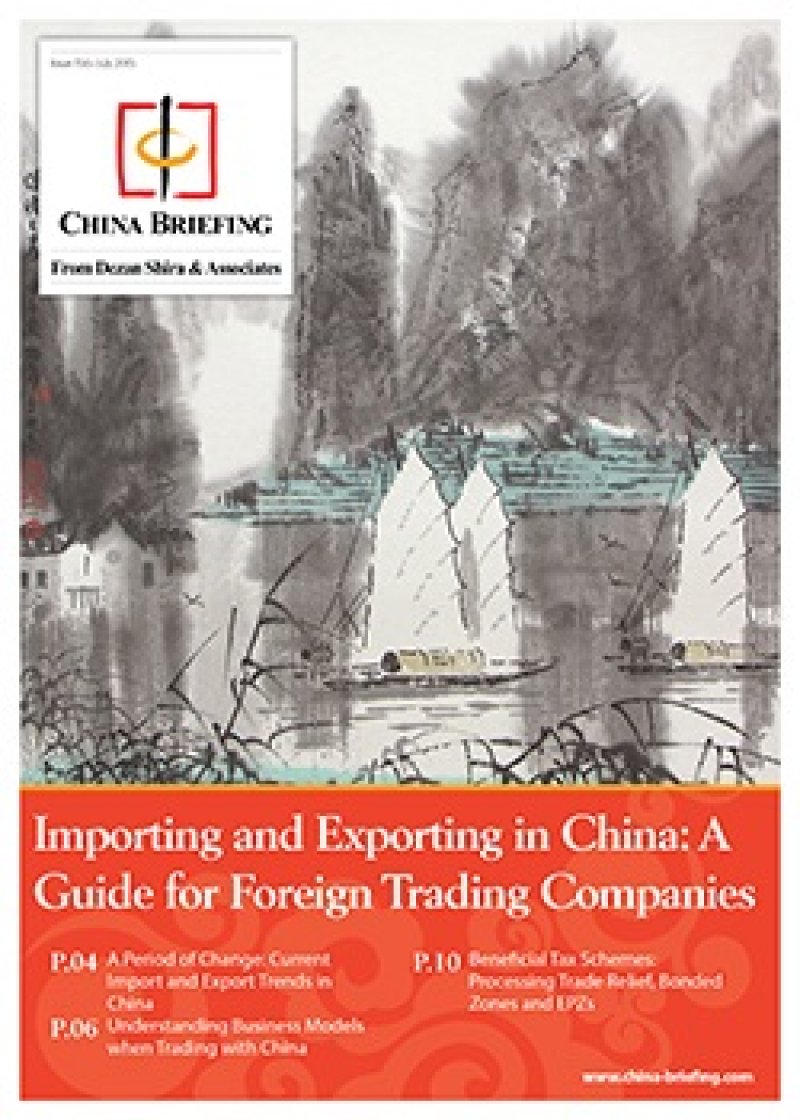Building for the Future: Selling Construction Materials in China
 By Dezan Shira & Associates
By Dezan Shira & Associates
Editor: Zhou Qian and Steven Elsinga
For the most part, the construction business in China is run by Chinese parties, and the construction materials sector is no different. China’s rapid urbanization has led to a surge in demand for resources, carrying a variety of economies around the world through a multiyear boom period. The production of construction materials and components from these imports has been largely dominated by local companies, but there are a number of niche markets within that sector where foreign companies have a distinct competitive advantage.
Market Overview and Opportunities for Foreign Players
Government Policy
While hard to penetrate from an economic point of view, the construction materials sector is largely
devoid of government restrictions. Every other year, China releases the so-called Catalogue for the
Guidance of Foreign Investment, a document that outlines the industries where foreign investment
is encouraged, restricted or prohibited. Industries listed as encouraged enjoy beneficial treatment such as tax breaks, while those in the restricted section require additional government approval, or come with caps on the percentage of shares a foreign party may own.
Construction materials, of whatever kind, are not restricted. Some of these are even encouraged, including materials that conserve energy, are used in waste treatment, or replace wood and steel. As the final months of 2015 draw near, the CCP’s twelfth Five Year Plan (2011-2015) will soon come to an end. A relic from the days of China’s planned economy, the Five Year Plans lay out the government’s major policy goals. Already a concern at the previous session, recent months have seen a host of supportive government measures come out in anticipation of the new Plan. For example, on March 16, 2015, the New Type of Urbanization Plan 2014-2020 was promulgated, mandating the share of ‘green’ buildings in new construction to rise from two percent in 2012 to 50 percent in 2020. As the vast majority of Chinese suppliers are still unfamiliar with green materials, this policy decision offers a lucrative opportunity for foreign investors.
This direction was reiterated in the Opinions on Accelerating the Construction of Ecological Civilization, a policy document released by the State Council on April 25, 2015. Moreover, to promote the development of new types of wall materials such as light partition boards or composite insulating bricks, the Ministry of Finance and the State Administration of Taxation jointly released a Circular on June 12, 2015, offering producers of qualifying products a 50
percent VAT refund. Where the wall materials have been produced with recycled construction waste, 70 percent of VAT is refunded. The release of such stimulating measures is expected to continue after the new Five Year Plan is unveiled.

Market Analysis
As mentioned before, a large swath of the construction materials industry is serviced by domestic players. Nevertheless, there are a number of niche markets at the top end of the technology and quality spectrum that hold interesting opportunities for foreign investors. With the Chinese burgeoning middle class becoming increasingly quality-conscious, and with environmental issues remaining a pressing concern, foreign companies can bring technology and knowhow to the Chinese market that local providers are unable to offer.
In line with the increasing concern over energy efficiency, quality and pollution, demand for a number of related product categories has seen an upsurge. The first area where building quality starts to matter is, of course, safety. As such, there is increased attention to equip buildings with better performing fire- and shock-resistant materials. The scenes of the 2008 earthquake in Sichuan that killed almost 70,000 people are still fresh in many peoples’ memory. As most cities in China are plagued with high levels of air pollution, demand has been strong for air purification systems as well.
Since large parts of China use coal for energy production, any large scale energy savings will positively impact air quality as well. Apart from better isolation materials, solar panels and other energy generating devices will too see strong demand. Lastly, as the use of smart technologies such as intelligent light control and self adjusting temperature devices begin to find their way into everyday use, foreign investors can expect these trends to be picked up in China as well.
Do-it-yourself
Foreign investors should be aware that the concept of DIY home renovation is not common in China. When renovating a house, Chinese homeowners tend to hire a builder to do the work. The homeowner either buys the materials from a wholesale market for the builder to use, or has the builder purchase them directly. Several foreign companies have attempted to develop a retail market for building materials, but these efforts so far have failed to materialize.
 RELATED: Pre-Investment and Entry Strategy Advisory
RELATED: Pre-Investment and Entry Strategy Advisory
Administrative Measures in the Construction Materials Industry
National licensing requirements
The production and sale of several construction materials is subject to a licensing regime. Regulations on the matter are issued by the Administration for Quality Supervision, Inspection and Quarantine (AQSIQ), a government body charged, among other things, with commodity inspections. There is no uniform procedure for all categories of construction materials, so regulations differ per product. As an example, we examined the procedure for water-resistant materials.
Water-resistant materials
Applications for a water-resistant materials production license need to be addressed to the provincial branch of AQSIQ, and generally follow four steps:
1. Submission of the application materials (reply within 5 days), including:
a. Business license
b.Environmental protection valuation report issued by the Environment Protection Bureau
c. Application documents
2. On-site inspection (1 day)
3. Sampling test (reply within 15 days)
4. Examination of materials and approval (reply within 60 days)
Local licensing requirements
Some cities have enacted regulations with more detailed filing requirements for the production or sale of building materials. For example, Shanghai requires producers and importers of a wide variety of construction materials to file the materials used, submitting a compliance certificate from a testing institution, product warranty, production license (if required), or documents stating that the material has been approved for use abroad.
 This article is an excerpt from the August issue of China Briefing Magazine, titled “China Investment Roadmap: the Commercial Real Estate Sector” In this issue of China Briefing, we explore the latest trends in commercial real estate in China, and discuss how foreign companies can benefit from China’s massive construction boom. We provide a guide to how firms can sell construction materials in China, and finally detail how foreign architects can most effectively enter and take advantage of China’s rapid urbanization. This article is an excerpt from the August issue of China Briefing Magazine, titled “China Investment Roadmap: the Commercial Real Estate Sector” In this issue of China Briefing, we explore the latest trends in commercial real estate in China, and discuss how foreign companies can benefit from China’s massive construction boom. We provide a guide to how firms can sell construction materials in China, and finally detail how foreign architects can most effectively enter and take advantage of China’s rapid urbanization. |
![]()
Importing and Exporting in China: a Guide for Trading Companies
In this issue of China Briefing, we discuss the latest import and export trends in China, and analyze the ways in which a foreign company in China can properly prepare for the import/export process. With import taxes and duties adding a significant cost burden, we explain how this system works in China, and highlight some of the tax incentives that the Chinese government has put in place to help stimulate trade.
 Adapting Your China WFOE to Service China’s Consumers
Adapting Your China WFOE to Service China’s Consumers
In this issue of China Briefing Magazine, we look at the challenges posed to manufacturers amidst China’s rising labor costs and stricter environmental regulations. Manufacturing WFOEs in China should adapt by expanding their business scope to include distribution and determine suitable supply chain solutions. In this regard, we will take a look at the opportunities in China’s domestic consumer market and forecast the sectors that are set to boom in the coming years.
 China Retail Industry Report 2014
China Retail Industry Report 2014
In this special edition of China Briefing, we provide an overview of the retail industry in China and the procedures for setting up a retail shop, focusing specifically on brick-and-mortar physical retail stores. Further, we have invited our partner Direct HR to offer some insights on the talent landscape in the retail industry, as well as tips for recruiting retail personnel in China.
- Previous Article Investing in China’s Heavy Lift Helicopter Market
- Next Article Outlook on Light Manufacturing in China: November 2015










